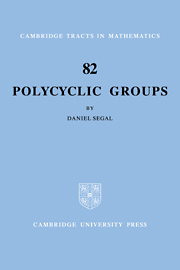Book contents
- Frontmatter
- Contents
- Preface
- Notation
- 1 The elements
- 2 Mal'cev's theorems
- 3 Extensions
- 4 Arithmetical methods
- 5 Faithful representations
- 6 On unipotent groups
- 7 Semi-simple splitting
- 8 Soluble ℤ-linear groups
- 9 A finiteness theorem
- 10 Polycyclic groups with isomorphic finite quotients
- 11 Examples
- Appendix: further topics
- References
- Index
- Frontmatter
- Contents
- Preface
- Notation
- 1 The elements
- 2 Mal'cev's theorems
- 3 Extensions
- 4 Arithmetical methods
- 5 Faithful representations
- 6 On unipotent groups
- 7 Semi-simple splitting
- 8 Soluble ℤ-linear groups
- 9 A finiteness theorem
- 10 Polycyclic groups with isomorphic finite quotients
- 11 Examples
- Appendix: further topics
- References
- Index
Summary
Nothing is simpler than a cyclic group. So if we build a group, starting from the identity, by a finite number of iterated extensions with cyclic groups, we would expect its structure to be pretty transparent. Such a group is called polycyclic.
In one sense, of course, polycyclic groups do have a transparent structure. But in the last few years, some remarkably intricate mathematics has been brought to bear on the study of these groups. Of course, the question of whether the end justifies the means is ultimately a matter of personal taste; to me, the picture which has begun to emerge is an attractive one. Working in this subject has given me a lot of pleasure, and if a little of that gets across to the reader of this book then the effort of writing it will have been well worth while.
This is not an encyclopaedic work on polycyclic groups. A number of thoroughly deserving topics have been omitted altogether, or merely touched on in the text (some of these, with references, are mentioned in the appendix). My guiding aim has simply been to present a connected account of some interesting mathematics, and throughout I have laid more stress on the ideas than on the results. In consequence, some of the results are given in lesser generality than they might be, and some of the proofs are leisurely where they could have been slick.
Information
- Type
- Chapter
- Information
- Polycyclic Groups , pp. ix - xiiPublisher: Cambridge University PressPrint publication year: 1983
